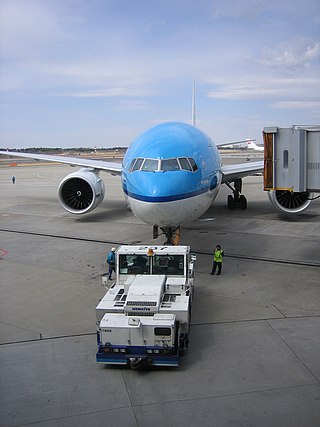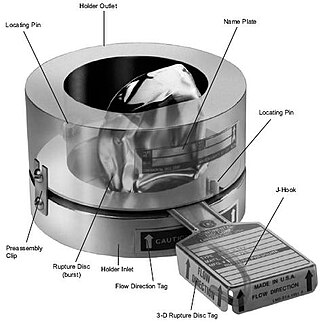As safeguards
In the role of a mechanical safeguard, a shear pin is a safety device designed to shear in the case of a mechanical overload, preventing other, more expensive or less-easily replaced parts from being damaged. As a mechanical sacrificial part, it is analogous to an electric fuse.
They are most commonly used in drive trains, such as a snow blower's auger or the propellers attached to marine engines.
Another use is in pushback bars used for large aircraft. In this device, shear pins are frequently used to connect the "head" of the towbar – the portion that attaches to the aircraft – to the main shaft of the towbar. In this way, the failure of the shear pin will physically separate the aircraft and the tractor. The design may be such that the shear pin will have several different causes of failure – towbar rotation about its long axis, sudden braking or acceleration, excessive steering force, etc. – all of which could otherwise be extremely damaging to the aircraft.
As conditional operators
In the role as a conditional operator, a shear pin will be used to prevent a mechanical device from operating before the criteria for operation are met. A shear pin gives a distinct threshold for the force required for operation. It is very cheap and easy to produce delivering a very high reliability and predictable tolerance. They are almost maintenance-free and can remain ready for operation for years with little to no decrease in reliability. Shear pins are only useful for a single operating cycle, after each operation they have to be replaced. A very simple example is the plastic or wire loop affixed to the handles of common fire extinguishers. Its presence prevents accidental discharge by only allowing the handle to be depressed once a high amount of initial force is applied; by breaking, it allows the handle to subsequently be depressed more easily.
Many designs take advantage of the maintenance-free state of constant readiness. For example, a hydraulic damper protecting a structure from earthquake damage could be secured with a shear pin. During normal conditions the system would be completely rigid, but when acted upon by the force of an earthquake the shear pin would break and the hydraulic damping system would operate.
Their high reliability and low cost make them very popular for use in weapons. A typical example is using shear pins in an explosive device. A shear pin can here hold a striker pin in place, preventing the striker pin from striking an initiator (primer) unless the correct force is applied. That force can be the acceleration of a rifle grenade being launched. The force would snap the shear pin, allowing the striker pin to move backwards onto a primer, which in turn ignites a pyrotechnic delay composition for auto destruction. In this use shear pins prevent the striker pin from hitting the primer during handling or if the grenade was dropped by accident. Additionally, shear-pins are frequently used in anti-tank mine fuzes, to prevent them from being triggered by much lighter, non-target vehicles such as motorcycles. Typically, the shear-pin in an anti-tank mine is designed to snap (and release the spring-loaded firing pin) when a weight in excess of 1500 kilograms is applied to the pressure plate.
Material
A shear pin could potentially be made from any material although metal is the most common.
When making a metal object for a mechanical application, an alloy and tempering is usually selected to make the construction resistant to damage. This can for example be achieved by giving the material a high degree of elasticity so that, like a spring, the metal returns to its original shape after being deformed by an external force. A shear pin however is often tempered to make the metal brittle, so that it breaks or shatters rather than bends when the required force is applied.
The material of a shear pin is selected and treated so that it is relatively resistant to fatigue. That is, when subjected to small forces, each one insufficient to break the pin, the pin does not retain damage. If material fatigue were to weaken a shear pin, the pin could potentially be broken by a force smaller than the original threshold force causing the mechanism to operate unintentionally, or a safety shear pin to break during normal operation of the machinery it protects.

A ceramic is any of the various hard, brittle, heat-resistant, and corrosion-resistant materials made by shaping and then firing an inorganic, nonmetallic material, such as clay, at a high temperature. Common examples are earthenware, porcelain, and brick.

Components of an electrical circuit are electrically connected if an electric current can run between them through an electrical conductor. An electrical connector is an electromechanical device used to create an electrical connection between parts of an electrical circuit, or between different electrical circuits, thereby joining them into a larger circuit. Most electrical connectors have a gender – i.e. the male component, called a plug, connects to the female component, or socket. The connection may be removable, require a tool for assembly and removal, or serve as a permanent electrical joint between two points. An adapter can be used to join dissimilar connectors.
A torque wrench is a tool used to apply a specific torque to a fastener such as a nut, bolt, or lag screw. It is usually in the form of a socket wrench with an indicating scale, or an internal mechanism which will indicate when a specified (adjustable) torque value has been reached during application.

In electronics, a limiter is a circuit that allows signals below a specified input power or level to pass unaffected while attenuating (lowering) the peaks of stronger signals that exceed this threshold. Limiting is a type of dynamic range compression. Clipping is an extreme version of limiting.

In electronics and electrical engineering, a fuse is an electrical safety device that operates to provide overcurrent protection of an electrical circuit. Its essential component is a metal wire or strip that melts when too much current flows through it, thereby stopping or interrupting the current. It is a sacrificial device; once a fuse has operated it is an open circuit, and must be replaced or rewired, depending on its type.

A firing pin or striker is a part of the firing mechanism of a firearm that impacts the primer in the base of a cartridge and causes it to fire. In firearms terminology, a striker is a particular type of firing pin where a compressed spring acts directly on the firing pin to provide the impact force rather than it being struck by a hammer.

Door furniture or door hardware refers to any of the items that are attached to a door or a drawer to enhance its functionality or appearance.
An interference fit, also known as a pressed fit or friction fit, is a form of fastening between two tightfitting mating parts that produces a joint which is held together by friction after the parts are pushed together.

A jackscrew, or screw jack, is a type of jack that is operated by turning a leadscrew. It is commonly used to lift moderately and heavy weights, such as vehicles; to raise and lower the horizontal stabilizers of aircraft; and as adjustable supports for heavy loads, such as the foundations of houses.

A hydraulic cylinder is a mechanical actuator that is used to give a unidirectional force through a unidirectional stroke. It has many applications, notably in construction equipment, manufacturing machinery, elevators, and civil engineering. A hydraulic cylinder is a hydraulic actuator that provides linear motion when hydraulic energy is converted into mechanical movement. It can be likened to a muscle in that, when the hydraulic system of a machine is activated, the cylinder is responsible for providing the motion.

In aviation, pushback is an airport procedure during which an aircraft is pushed backwards away from its parking position, usually at an airport gate by external power. Pushbacks are carried out by special, low-profile vehicles called pushback tractors or tugs.

A fixture is a work-holding or support device used in the manufacturing industry. Fixtures are used to securely locate and support the work, ensuring that all parts produced using the fixture will maintain conformity and interchangeability. Using a fixture improves the economy of production by allowing smooth operation and quick transition from part to part, reducing the requirement for skilled labor by simplifying how workpieces are mounted, and increasing conformity across a production run.
Electronic packaging is the design and production of enclosures for electronic devices ranging from individual semiconductor devices up to complete systems such as a mainframe computer. Packaging of an electronic system must consider protection from mechanical damage, cooling, radio frequency noise emission and electrostatic discharge. Product safety standards may dictate particular features of a consumer product, for example, external case temperature or grounding of exposed metal parts. Prototypes and industrial equipment made in small quantities may use standardized commercially available enclosures such as card cages or prefabricated boxes. Mass-market consumer devices may have highly specialized packaging to increase consumer appeal. Electronic packaging is a major discipline within the field of mechanical engineering.

The hammer is a part of a firearm that is used to strike the percussion cap/primer, or a separate firing pin, to ignite the propellant and fire the projectile. It is so called due to the fact that it resembles a hammer in both form and function. The hammer itself is a metal piece that forcefully rotates about a pivot point.

A rupture disk, also known as a pressure safety disc, burst disc, bursting disc, or burst diaphragm, is a non-reclosing pressure relief safety device that, in most uses, protects a pressure vessel, equipment or system from overpressurization or potentially damaging vacuum conditions.

Electronic components have a wide range of failure modes. These can be classified in various ways, such as by time or cause. Failures can be caused by excess temperature, excess current or voltage, ionizing radiation, mechanical shock, stress or impact, and many other causes. In semiconductor devices, problems in the device package may cause failures due to contamination, mechanical stress of the device, or open or short circuits.

In firearms, a safety or safety catch is a mechanism used to help prevent the accidental discharge of a firearm, helping to ensure safer handling.
Most of the terms listed in Wikipedia glossaries are already defined and explained within Wikipedia itself. However, glossaries like this one are useful for looking up, comparing and reviewing large numbers of terms together. You can help enhance this page by adding new terms or writing definitions for existing ones.

A glass breaker is a hand tool designed to break through a window glass in an emergency. It is a common safety device found in vehicles to aid in the emergency extrication of occupants from a vehicle, as well as in some buildings.
This is a glossary of locksmithing terms.















